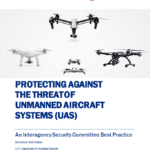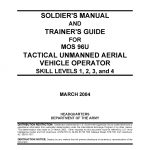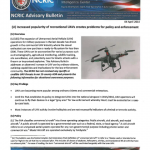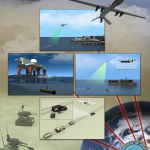
This document provides guidance for federal Executive Branch departments and agencies regarding best practices, lessons learned, and recommendations to protect against the threat of malicious unmanned aircraft systems (UAS) operations.

This manual identifies the individual MOS training requirements for soldiers in MOS 96U. Commanders, trainers, and soldiers should use it to plan, conduct, and evaluate individual training in their unit. This manual is the primary MOS reference to support the self-development and training of every 96U soldier.

The expansion of Unmanned Aerial Vehicle (UAV) operations for military purposes in the last decade has driven growth in the commercial UAV industry where. the casual enthusiast can now purchase a ready-to-fly system for less than $300. These UAVs can be accessorized for varied purposes such as cinematography, agricultural monitoring, wildlife tracking, site surveillance, and potentially even for kinetic attacks with a firearm or improvised explosive. This Advisory Bulletin addresses an observed increase in UAV use by ordinary citizens, outlining capabilities and implications for the law enforcement community. The NCRIC has not received any specific or credible UAV threats in our 15-county AOR and presents the following information for situational awareness purposes.

The purpose of this Roadmap is to articulate a vision and strategy for the continued development, production, test, training, operation, and sustainment of unmanned systems technology across DoD. This “Unmanned Systems Integrated Roadmap” establishes a technological vision for the next 25 years and outlines actions and technologies for DoD and industry to pursue to intelligently and affordably align with this vision.
In the last 10 years, the unmanned aircraft system (UAS) has captured the public’s imagination and fascination with their ability to provide instantaneous video feeds of military and covert CIA operations in far away places like Afghanistan and Iraq. The rapid proliferation of the UAS and the eventual redeployment of current systems deployed to Afghanistan and Iraq will require the Federal Aviation Administration (FAA) to provide unrestricted unmanned aircraft access within the National Airspace System (NAS). The Department of Defense (DoD) requires routine access to the NAS to execute directed missions, meet training requirements, and perform necessary testing to meet the Joint Force Commander’s (JFC’s) established mission priorities. Over the past several years, the DoD has been able to execute a small portion of UAS flights in the NAS but current rules and regulation do not facilitate seamless integration with manned aircraft. The purpose of this study is to show that although the DoD and the FAA recognize the importance of integrating manned and unmanned aircraft within the NAS, there are many challenges and gaps that must be bridged to facilitate successful integration. The most important challenge to overcome when integrating manned and unmanned aircraft into the same airspace is safety.
These photos were taken in March 2010 at Davis-Monthan AFB in Tucson, Arizona. See also: What Happens When You Protest a Weapons Factory https://publicintelligence.net/what-happens-when-you-protest-a-weapons-factory/
During the month of April 2010, we have received the same message twice from the Las Vegas Metropolitan Police Department concerning a Law Enforcement Sensitive brief entitled “Silver Shield: Nevada’s Approach to Critical Infrastructure Protection” from November 2007. The briefing discusses various aspects of Suspicious Activity Reporting, Fusion Center integration, and the use of unmanned aerial vehicles (UAV) to patrol portions of the city for aerial photography during incident response.
Provides Unmanned Aircraft System (UAS), operations, maintenance, technical support, pilots, and sensor operators to surveil the Southwest border of the United States. Over the next several years UAV border surveillance will improve sensor/video surveillance capabilities of the current, monitored base system through persistent 24 hours per day / 7 days per week surveillance; integrate new surveillance technologies (aerial sensor suites), and increase interoperability with other law enforcement agencies and initiatives.
The Navy’s Airworthiness Office (AIR-4.0P) is responsible for the independent engineering assessment of all aircraft (manned and unmanned) and airborne weapon systems to ensure these air vehicles can be operated safely within defined operating limits.